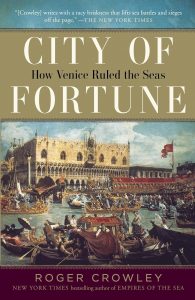From the Archives: City of Fortune
I am deep in reviewing the index for The Dragon from Chicago, which has turned out to be a much harder and more fiddly task than I anticipated.* Nonetheless, I full intended to give you a new blog post today. I really tried, but after an hour I was forced to admit that the idea just didn’t work. Instead, I offer you this post from April, 2012. Reading this twelve years later made me want to pull City of Fortune off the shelves for a re-read on this snowy April day. But I must remain strong. Index, here I come.
***
I thought I knew something about Venice. A floating city carved out of a malaria-ridden lagoon. Merchant city-state turned maritime empire, with one foot in the Muslim world. The European end of the desert caravan trade, with merchant entrepôts throughout the Levantine coast. Canals, gondoliers, masked balls, gold ducats. Glamor, wealth, decadence, decay. Or perhaps, in the words of Lerner and Lowe, “just a town without a sewer.”
Then I got a chance to review Roger Crowley’s City of Fortune: How Venice Ruled the Seas for Shelf Awareness for Readers and discovered I knew nothing about Venice.
Roger Crowley returns to the medieval and early modern Mediterranean in City of Fortune, using three defining moments to tell the story of Venice’s development from a “smattering of low-lying muddy islets set in a malarial lagoon” to the greatest power in the region: the city-state’s pivotal role in the Fourth Crusade and the sacking of Constantinople in 1204; Venice’s bloody rivalry with Genoa for control of the East-West trade; and its desperate defense against the Ottoman Empire’s expansion into the Mediterranean in the fifteenth century.
As in his earlier books, Crowley’s fast-paced narrative style and vivid character sketches strike a nice balance between the big picture and the telling detail. He tells the story using a variety of voices. In addition to accounts by Venetian doges, merchants and city officials, he uses those written by–often hostile–outsiders, including the poet Petrarch, Pope Innocent III, Norman crusaders, and Cretan rebels.
Trade is the theme that ties Crowley’s story together. With no natural resources, no agriculture, and a small population, Venice depended entirely on trade for its survival. Its relationships first with Byzantium and later with the Islamic world were both the foundation of its prosperity and a source of contention with the rest of Christendom. Control of the western end of the overland trade caravans was the key to Venice’s success as “Europe’s first full-blown colonial adventure.” Crowley ends with the event that would bring Venetian maritime dominance to a close: the news that Portugal had found a sea route to India, rendering the Venetian empire suddenly obsolete.
*Writing the book is just the first of many steps that you take on the way to a published book. And all of them are time-consuming.





